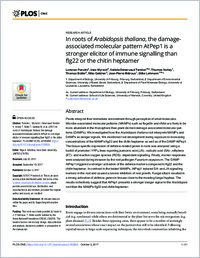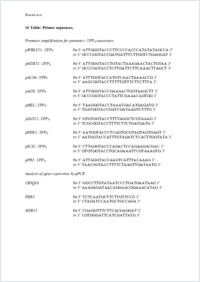In roots of Arabidopsis thaliana, the damage-associated molecular pattern AtPep1 is a stronger elicitor of immune signalling than flg22 or the chitin heptamer
- Poncini, Lorenzo Department of Biology, University of Fribourg, Fribourg, Switzerland,
- Wyrsch, Ines Department of Environmental Sciences, University of Basel, Basel, Switzerland,
- Dénervaud Tendon, Valérie Department of Plant Molecular Biology, University of Lausanne, Lausanne, Switzerland - Department of Biology, University of Fribourg, Fribourg, Switzerland,
- Vorley, Thomas Department of Biology, University of Fribourg, Fribourg, Switzerland,
- Boller, Thomas Department of Environmental Sciences, University of Basel, Basel, Switzerland,
- Geldner, Niko Department of Plant Molecular Biology, University of Lausanne, Lausanne, Switzerland
- Métraux, Jean-Pierre Department of Biology, University of Fribourg, Fribourg, Switzerland,
- Lehmann, Silke Department of Biology, University of Fribourg, Fribourg, Switzerland, - School of Life Sciences, University of Warwick, Coventry, United Kingdom
-
03.10.2017
Published in:
- PLOS ONE. - 2017, vol. 12, no. 10, p. e0185808
English
Plants interpret their immediate environment through perception of small molecules. Microbe-associated molecular patterns (MAMPs) such as flagellin and chitin are likely to be more abundant in the rhizosphere than plant-derived damage-associated molecular patterns (DAMPs). We investigated how the Arabidopsis thaliana root interprets MAMPs and DAMPs as danger signals. We monitored root development during exposure to increasing concentrations of the MAMPs flg22 and the chitin heptamer as well as of the DAMP AtPep1. The tissue-specific expression of defence- related genes in roots was analysed using a toolkit of promoter::YFPN lines reporting jasmonic acid (JA)-, salicylic acid (SA)-, ethylene (ET)- and reactive oxygen species (ROS)- dependent signalling. Finally, marker responses were analysed during invasion by the root pathogen Fusarium oxysporum. The DAMP AtPep1 triggered a stronger activation of the defence markers compared to flg22 and the chitin heptamer. In contrast to the tested MAMPs, AtPep1 induced SA- and JA-signalling markers in the root and caused a severe inhibition of root growth. Fungal attack resulted in a strong activation of defence genes in tissues close to the invading fungal hyphae. The results collectively suggest that AtPep1 presents a stronger danger signal to the Arabidopsis root than the MAMPs flg22 and chitin heptamer.
- Faculty
- Faculté des sciences et de médecine
- Department
- Département de Biologie
- Language
-
- English
- Classification
- Biological sciences
- License
- License undefined
- Identifiers
-
- RERO DOC 305615
- DOI 10.1371/journal.pone.0185808
- Persistent URL
- https://folia.unifr.ch/unifr/documents/305998
Other files
Statistics
Document views: 103
File downloads:
- met_rat.pdf: 156
- met_rat_sm.pdf: 75

